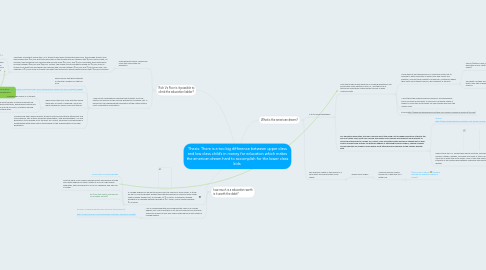
1. Rich Vs Poor is it possible to climb the education ladder?
1.1. What different social classes pay more than each other for education
1.1.1. The study found that among the 4,414 students who were tracked through 2009, the average student loan debt burden was $22,000. But those who were in that middle income category had $6,000 more in debt, on average, than did those from families with income under $40,000, and $2,000 more than those with family income between $60,000 and $99,000. Further, the middle-income students racked up $12,000 more in student loan debt than did those from families with income between $100,000 and $149,000 per year, and upwards of $17,000 more in student loan debt than those from families earning more than $150,000 annually.
1.1.1.1. sourcehttps://www.insidehighered.com/news/2012/08/20/sociologists-examine-patterns-student-debt-gender-and-class
1.1.1.2. the lower class tended to have a little bit lower student loans than the middle class because the low class have a lot of grants able for them and it's easier to get scholarships if your household has a bad income. also they know not to overspend money you don't have
1.2. “One recent investigation reported that students from the bottom 50 percent of the income distribution comprise just 14 percent of the undergraduate population at the United States’ most competitive universities.”
1.2.1. which means that 86% students on the top colleges is in the top 50%
1.2.2. source:http://www.theatlantic.com/education/archive/2013/09/no-point-in-applying-why-poor-students-are-missing-at-top-colleges/279699/
1.2.3. which leaves the poor class with the saying there was “no point in applying” since she didn’t believe her family could foot the bill.
1.2.3.1. a former high school 4.0 student.
1.2.3.2. there is something to be done though: Numerous families did not know that at some elite institutions, households earning less than $200,000 a year do not pay full price, and those earning less than $65,000 pay nothing at all.
1.2.3.2.1. Source:http://www.theatlantic.com/education/archive/2013/09/no-point-in-applying-why-poor-students-are-missing-at-top-colleges/279699/
1.2.4. And because their degree affects students’ lifelong educational attainment and job prospects, this system allows the advantages—and disadvantages—of one generation to be passed on to the next. As a result, America’s social hierarchy is perpetuated rather than restructured based on the achievements of the new generation.
2. What is the american dream?
2.1. Is it still accomplishable?
2.1.1. Now that a high school diploma no longer guarantees a job and middle-class lifestyle in the U.S., and the price of tuition has reportedly outpaced the income of even America’s elite
2.1.1.1. Those that do find themselves in a classroom often opt to prepare to enter industries in which jobs and money are plentiful, such as those related to economics, instead of where their skills and interests may be, like programs in the arts.
2.1.1.1.1. source:(Patrick Callan, president of the Higher Education Policy Institute, told MintPress News.)
2.1.1.1.2. And what can then be done to get out of the debt if you take a degree without having money?
2.1.1.2. I don't think the original american dream is accomplishable since you need a education to succed in life which makes it harder to climb the social ladder for poor people and even the middle class
2.1.1.3. source:http://www.mintpressnews.com/who-can-afford-college-in-america/190730/
2.1.2. For education advocates, the main concern about the rising cost of higher education is that as the price of tuition rises, many low-income and middle-class families are finding it more difficult to afford send their kids to college. As a result, many are entering the workforce straight out of high school and giving up entirely on getting a degree or attending technical school, making colleges and universities once again a place where most attendees are members of the nation’s wealthy elite.
2.1.2.1. source: http://www.mintpressnews.com/who-can-afford-college-in-america/190730/
2.1.2.2. Report finds the U.S. ranking well below Australia, Denmark, Norway, Finland, Canada, Sweden, Germany and Spain in terms of how freely citizens move up or down the social ladder. Only in Italy and Great Britain is the intensity of the relationship between individual and parental earnings even greater
2.1.2.2.1. Which makes the american dream a old saying and not a thing that accomplishable for all, or Atleast not as accomplish able as in the most part of western Europe.
2.1.2.2.2. source: http://www.huffingtonpost.com/2010/03/17/social-immobility-climbin_n_501788.html
2.1.2.2.3. I know that one of the reasons that Denmark, Norway, Finland and Sweden is more "climbable" countries is because education has little to no cost which means if you want to be educated you can just go ahead its not like you end up with 100 thousand dollars in study debt.
2.1.2.2.4. tip: (click the Statistics to get a big version)
2.2. The american dream is the dream of a fresh start and climbing the social ladder
2.2.1. Where did it origin?
2.2.1.1. It was commonly used in Europe as a "gate way to a better life.
2.2.1.1.1. ((source ind i historie 8) (student book about american history in danish)
3. how much is a education worth is it worth the debt?
3.1. A college degree can be worth millions over the course of one’s career. A study by the US Census Bureau showed the lifetime earnings of someone with a high school degree topped out, on average, at $1.2 million. A Bachelor’s Degree brought in an average lifetime earnings of $2.1 million, and a Master’s Degree $2.5 million.
3.1.1. Source the US Census Bureau
3.1.2. Also the odds of you being unemployment decreases a lot with each extra degree you take it starts at 9.7% for High school graduates, then goes down to 5.2% for a bachelor and 3.9% for a master.
3.1.3. tip (click the charts, pictures etc for a bigger version)
3.2. I am a college graduate and recognize the value of a college degree, but I also know that is not the only way to be successful. There are dozens of jobs and career fields which do not require a college degree.
3.2.1. Source a college graduate who wrote an article about it : http://cashmoneylife.com/relationship-between-education-wealth/
